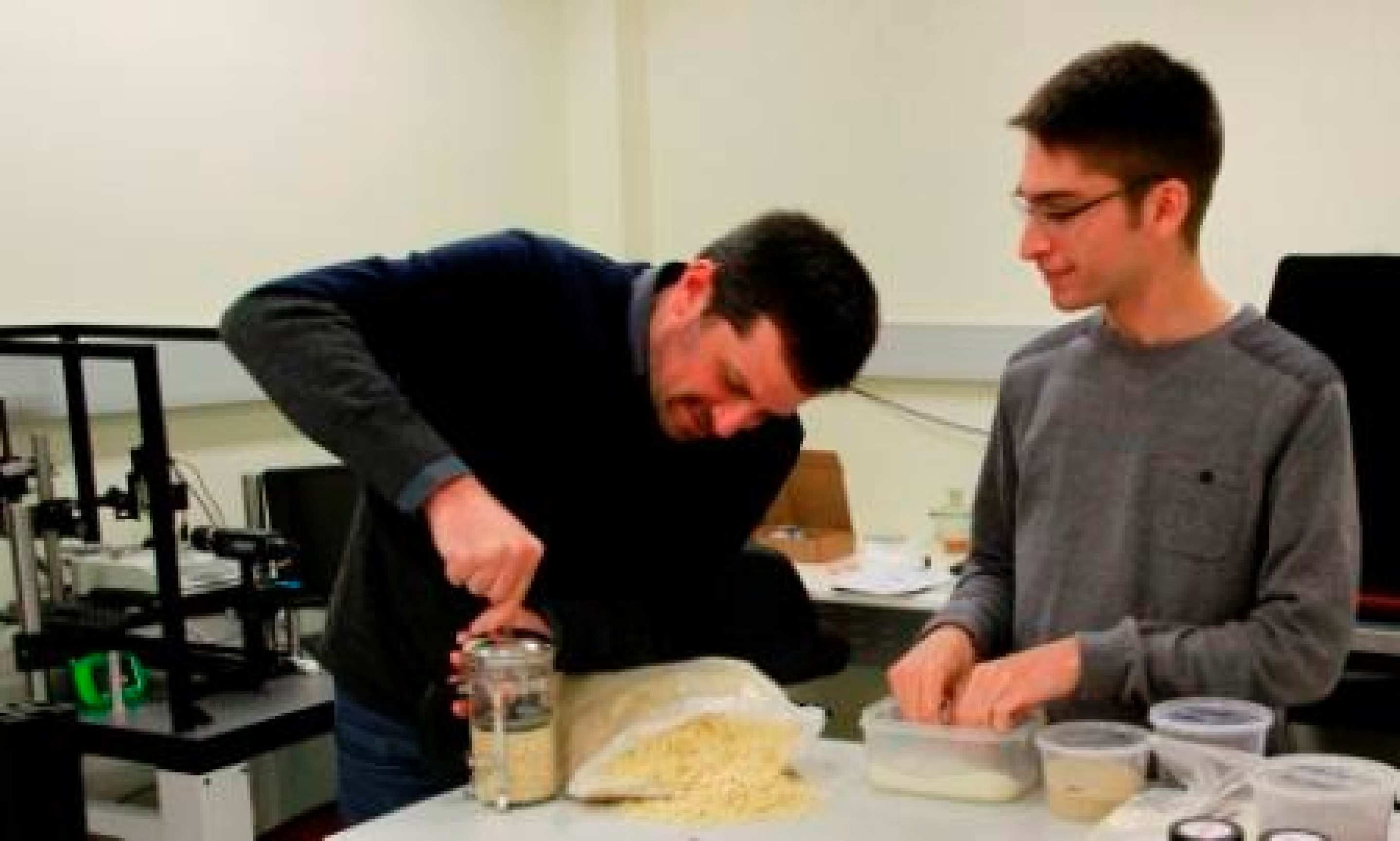Proof is in the breakfast cereal
The science of snap, crackle and pop has expanded beyond the breakfast bowl with an international research team using puffed rice cereal to explain the movement and crushing of porous materials when compressed.


Professor Itai Einav and Dr Francois Guillard work in the Particles and Grains Laboratory
The science of snap, crackle and pop has expanded beyond the breakfast bowl with an international research team using puffed rice cereal to explain the movement and crushing of porous materials when compressed.
Results of the work conducted by researchers from the universities of Sydney and San Diego State have been published today in the journal Nature Physics.
The Nature paper presents the team’s creative research approach to revealing the patterns of motions in brittle porous materials and their results will have an impact on our understanding of everything from snowballs colliding during avalanches to crater patterns formed during meteorite impacts.
Professor Itai Einav, lead author from the University of Sydney’s Particles and Grains Laboratory whose long-term research objectives have been focussed on understanding how grains behave under varying conditions says:
“Before we started we knew that brittle porous materials such as rocks, foams or even snow exhibit irreversible compaction patterns.
We see such patterns in Sydney’s sandstone all around us, but this geological imprint doesn’t tell us much about the internal motions and the process of pores collapsing within the rock mass. We know rocks move, but it takes millions of years.
“What we didn’t know is in what ways it moves and deforms, and specifically what types of internal patterns develop.
“We picked puffed rice because they are highly porous and compliant and typify generic brittle porous materials when being compressed.”
“We wanted to understand how packs of brittle grains coordinate motion when crushed. Many of us have tried this at home as kids – crushing puffed rice cereal with a spoon.
“For us this simple experiment revealed surprisingly rich compaction patterns that were due to the competing processes of internal collapse and recovery,” said Professor Einav.
The paper’s co-lead author Dr François Guillard also from the University of Sydney, who worked with Professor Julio Valdes at San Diego State University on the experiments, says the research model replicating the experiments offers a new perspective on jerky flows in metallic alloys.
“We used a robust spring-lattice model to capture the process of internal collapse and recovery and are now able explain the dynamics of previously and newly observed patterns.
“The lattice model we have created can address other brittle porous media such as natural rocks, bones and snow, and manmade ceramics, foams and pharmaceutical powders,” says Dr Guillard.
Professor Einav is internationally recognised for producing scientifically driven engineering methods, such as new experimental facilities for determining material strength and mathematical formulae that have impacted geotechnical practice and bulk handling of powders and grains.
Media contact: Victoria Hollick, T 9351 2579, M 0401 711 361 E victoria.hollick@sydney.edu.au
Related articles
Resetting the table to halt expanding waistlines
Can farmers, producers and regulators work together at all points of the food supply chain to help curb Australia’s growing obesity problem?

Eureka Prize for Associate Professor Michael J. Biercuk
Associate Professor Biercuk was recognised with the prestigious prize for contributions at the leading edge of quantum science research.
Scientists should take a leaf out of wellness bloggers' books
How can we distinguish credible wellness information from unfounded pseudoscience? And why is it that wellness gurus are often taken more seriously than scientists? Jackie Randles writes.
18 of our most exciting scientists on Twitter
It's National Science Week this week from 15-23 August and for all you science lovers, we have created a list of the University of Sydney's most exciting scientists on Twitter.
How Einstein could help unlock the mysteries of space travel
Warp drives might be the stuff of science fiction, but they could be a step closer to reality if we look to Einstein's theory of gravity, according to a University of Sydney researcher.
University of Sydney celebrates Sydney Science Festival
From Einstein's theory of gravity to Aboriginal astronomical knowledge, University of Sydney researchers are proving there's no single formula for exploring a love of science this National Science Week.
How mobile phones could save us from obesity
A world-first intervention designed by Charles Perkins Centre researchers specifically for young people found mobile phones could improve health and halt weight gain.
Starchy carbs, not a Paleo diet, advanced the human race
Starchy carbohydrates were a major factor in the evolution of the human brain, according to a new study co-authored by researchers from the University of Sydney's Charles Perkins Centre and Faculty of Agriculture and Environment.
Big data maps world's ocean floor
Scientists from the University of Sydney's School of Geosciences have led the creation of the world's first digital map of the seafloor's geology.
Insights from Australia's first scientists set in stone
Visitors can marvel at a dazzling display of ancient Aboriginal stone tools and learn how Indigenous scientific knowledge spanned the millennia at a University of Sydney talk this week.